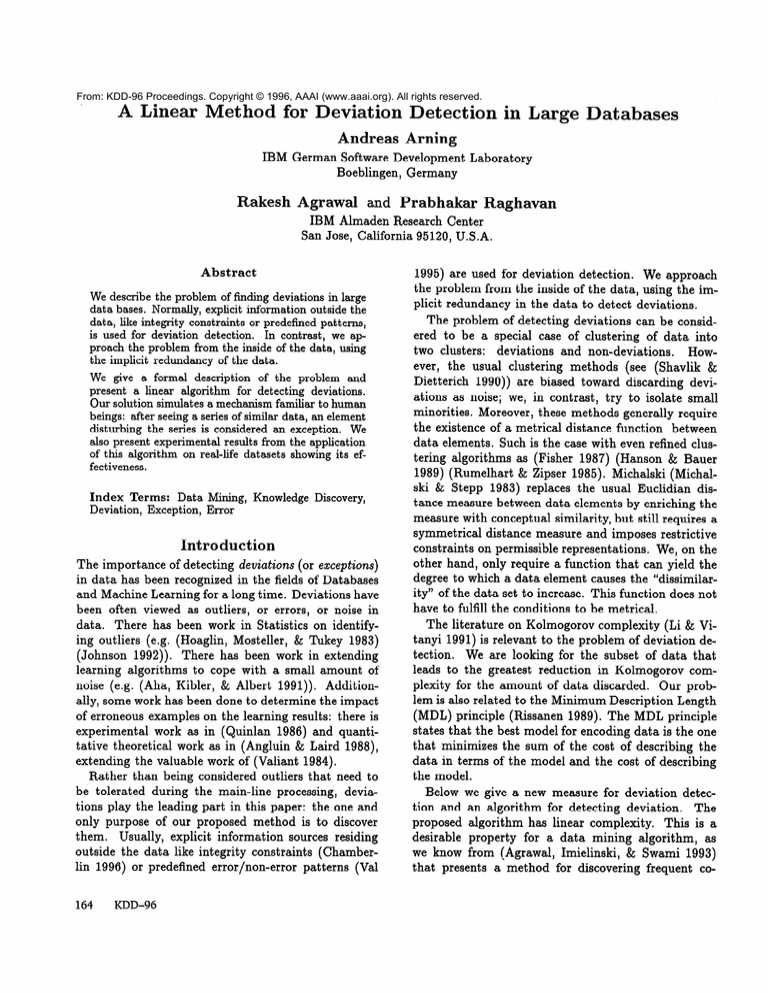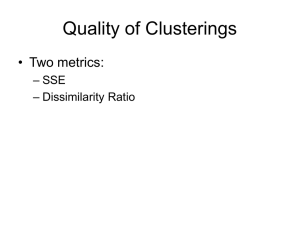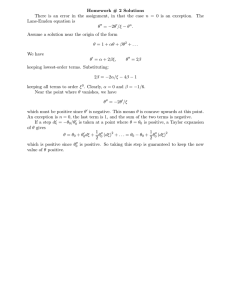
From: KDD-96 Proceedings. Copyright © 1996, AAAI (www.aaai.org). All rights reserved.
A Linear
Method
for Deviation
Andreas
Detection
Agrawal
Databases
Arning
IBM German Software Development
Boeblingen, Germany
Rakesh
in Large
and Prabhakar
Laboratory
Raghavan
IBM Almaden Research Center
San Jose, California 95120, U.S.A.
Abstract
We describe the problem of finding deviations in large
data bases. Normally, explicit information outside the
data, like integrity constraints or predef%ned patterns,
is used for deviation detection.
In contrast, we approach the problem from the inside of the data, using
the implicit redundancy of the data.
We give a formal description of the problem and
present a linear algorithm for detecting deviations.
Our solution simulates a mechanism familiar to human
beings: after seeing a series of similar data, an element
disturbing the series is considered an exception. We
also present experimental results from the application
of this algorithm on real-life datasets showing its effectiveness.
Index Terms:
Data Mining,
Deviation, Exception, Error
Knowledge
Discovery,
Introduction
The importance of detecting deviations (or exceptions)
in data has been recognized in the fields of Databases
and Machine Learning for a long time. Deviations have
been often viewed as outliers, or errors, or noise in
data. There has been work in Statistics on identifying outliers (e.g. (Hoaglin, Mosteller, & Tukey 1983)
(Johnson 1992)). There has been work in extending
learning algorithms to cope with a small amount of
noise (e.g. (Aha, Kibler, & Albert 1991)). Additionally, some work has been done to determine the impact
of erroneous examples on the learning results: there is
experimental work as in (Quinlan 1986) and quantitative theoretical work as in (Angluin & Laird 1988),
extending the valuable work of (Valiant 1984).
Rather than being considered outliers that need to
be tolerated during the main-line processing, devis
tions play the leading part in this paper: the one and
only purpose of our proposed method is to discover
them, Usually, explicit information sources residing
outside the data like integrity constraints (Chamberlin 1996) or predefined error/non-error
patterns (Val
164
KDD-96
1995) are used for deviation detection. We approach
the problem from the inside of the data, using the implicit redundancy in the data to detect deviations.
The problem of detecting deviations can be considered to be a special case of clustering of data into
two clusters: deviations and non-deviations.
However, the usual clustering methods (see (Shavlik &
Dietterich 1990)) are biased toward discarding deviations as noise; we, in contrast, try to isolate small
minorities. Moreover, these methods generally require
the existence of a metrical distance function between
data elements. Such is the case with even refined clustering algorithms as (Fisher 1987) (Hanson & Bauer
1989) (Rumelhart & Zipser 1985). Michalski (Michalski & Stepp 1983) replaces the usual Euclidian distance measure between data elements by enriching the
measure with conceptual similarity, but still requires a
symmetrical distance measure and imposes restrictive
constraints on permissible representations. We, on the
other hand, only require a function that can yield the
degree to which a data element causes the “dissimilarity” of the data set to increase. This function does not
have to fulfill the conditions to be metrical.
The literature on Kolmogorov complexity (Li & Vitanyi 1991) is relevant to the problem of deviation detection
We are looking for the subset of data that
leads to the greatest reduction
in Kolmogorov complexity for the amount of data discarded. Our problem is also related to the Minimum Description Length
(MDL) principle (Rissanen 1989). The MDL principle
states that the best model for encoding data is the one
that minimizes the sum of the cost of describing the
data in terms of the model and the cost of describing
the model.
Below we give a new measure for deviation detection and an algorithm for detecting deviation.
The
proposed algorithm has linear complexity.
This is a
desirable property for a data mining algorithm, as
we know from (Agrawal, Imielinski, & Swami 1993)
that presents a method for discovering frequent co-
occurrences of attribute values in large data sets. But
the goal of that algorithm is quite different, and the
performance of this system ((Agrawal & Srikant 1994))
is a consequence of ignoring early the seldom occurring
values - thus the possible exceptions.
Problem
Description
We begin by giving a formal definition of the deviation
detection problem.
Exact
Exception
l
a set of items I (and thus its power set P(l));
l
a dissimilarity
function V: P(1) + lR$;
a cardinality function C: P(1) + lRt, with
11 C Is * C(Il) < C(Is) for all 11, I2 c I.
Define for each Ij C I, the smoothing factor:
SF(lj)
:= C(I - Ij) * (V(I)
- V(1 - I.)).
We say that Is c I, Is # I is an exception set of I with
respect to V and C if
SF(&)
2 SF(&)
for all Ij C I.
Notes
Intuitively, an exception set is the subset of items
that contributes most to the dissimilarity of the
itemset I with the least number of items.
The smoothing factor indicates how much the dissimilarity can be reduced by removing a subset Ij
of elements from the set I. Observe that SF may
be negative for some subset Ij if the dissimilarity of
I - Ij is higher than that of the original set I.
While V(I - &) - the dissimilarity of the reduced
set - is important in finding the exception set I%,
the dissimilarity V(I,) of the exception set itself is
not considered. Nevertheless, it may be valuable to
take into account V(&) in further evaluation of the
exception set.
For V, any function can be used that returns a low
value if the elements of I are similar to each other,
and a higher value if the elements are dissimilar.
This function does not require a metrical distance
between the items.
In the most simple case, the function C(I - Ij) may
return II- Ij I, the number of items in the set I - Ij.
However, to favor small exception sets, this function
may be defined by a formula such as C(I - Ij) =
l-&i*
The exception set need not be unique. It can also
be empty, e.g. if all items in I are identical. The
smoothing factor is 0 in that case.
Example
Let
the set I be the set of integer values {1,4,4,4};
the dissimilarity
function V:
P(1) + IR$ be
the variance of the numbers in the set, i.e. h x
g,
Problem
Given:
l
l
(Xi - q2;
the cardinality function C: P(1) + IR$ be the count
of elements in the set.
By computing for each candidate exception set Ij
the smoothing factor SF(1j), we get:
I.
0
(41
WI
w,41
W
WI
u,4,41
I- Ij
u,4,4,41
UMI
WI
(11
-@,4,4~
WI
(41
C(I-Ij)
4
3
2
1
3
2
1
D(IIj)
1.69
2.00
2.25
0.00
0.00
0.00
0.00
SF(Ij)
0.00
-0.94
-1.13
1.69
5.06
3.38
1.69
Thus, the candidate set Ij = (1) and only this one
qualifies as exception set Iz with respect to the specified C and 2) functions.
Sequential
Exception
Problem
There are choices of the functions C and V for
which the exact exception problem is trivial to solve.
There are others for which it is non-trivial but still
polynomial-time.
For example, given a set of numbers,
consider finding the subset whose removal results in the
greatest reduction in the variance of the residual set,
per element removed (or any similar cardinality function). A priori it is not clear how to do this, but the
following schema works: sort the numbers in decreasing order of the distance from their mean. Discard the
numbers one by one in this order and at each point
compute the smoothing factor. After we have examined all the numbers in this fashion, we would have
seen the optimal subset at some point. This example
is interesting because it is a case where the optimal order for considering subsets can be computed efficiently.
However, one cannot hope to always find an efficient
ordering for examining the elements that yields the optimal solution for every C and V. Indeed, there exist C
and 2) for which the problem is NP-hard by a reduction
from Maximum Independent Set in a graph (Garey &
Johnson 1979). This motivates the definition of the
sequential exception problem.
Prediction 6t Deviation
165
Sequent ial Except ion
a set of items I (and thus its power set P(1));
a sequence S of n subsets 11,12, . . . . I. with 2 < n 5
]I], Ij C 1, and I’-1 C Ij;
a dissimilarity
spect to S;
function
Vs:
P(1)
+ lR;f‘ with re-
P4
Define for each Ij in S, the smoothing factor:
:= C(lj - rj-1)
* (vS(lj)
- vS(Ij-1)).
We say that Iz C I, Iz = (Ij -Ij-l),j
> 1 is a sequential exception set of I with respect to VS, C, and the
sequence S if
SF’(I,)
2 SF’(lj)
for all Ij occurring in S.
Observe that the smoothing factor SF for each subset Ij considers the dissimilarity difference with the
preceding subset in S instead of considering the dissimilarity of the complementary set (I - Ij) and I.
The sequential exception simulates a mechanism familiar to human beings: after seeing a series of similar
data, an element disturbing the series is considered an
exception, even without being told explicitly the rules
of well-formedness.
VS(lj)
WI
-
Vs(Ij-1).
Consider that element ij with the maximal value
of dj > 0 to be the answer for this iteration;
if dj 5 0 for all Ii in S, there is no exception.
[3] If an exception
a cardinality function C: P(1) + lR$’ with
11 C I2 * C(1i) < C(12) for all 13.,12 C I.
SF’(Ij)
=
dj
Given:
ij is found in step [2.3], do step [3.1]:
For each element ik, k
U {ik))
dko = Vs(lj-1
=
Vs(Ij
U
(ik))
dk,
Add to 1, those ik for
> j compute
- Vs(lj-1)
and
Vs(Ij).
which dk, - dkl > dj.
[4] We now potentially have m competing exception
sets 1%, corresponding to each iteration. Select the
one with largest value of difference in dissimilarity
dj, scaled with the cardinality function C.
Notes
Steps [2.1] through [2.3] are performed m times on
after randomizing the order of items in input to alleviate the sensitivity of results to the order of input.
For a motivation for Step [3.1], consider a degenerate
scenario. Suppose ij is such that Vs (1j) - Vs (1j _ 1)
is large so that ij is a candidate exception.
Now
let ij+l be identical to ij. In that case, Vs(1j+i)
Vs(lj) will be 0 and ij+i will not be considered an
exception. In general, there may be items il, following ij that would have caused increase in the dissimilarity, but for the presence of ij. Step [3.1] adds all
such items to the exception set.
Algorithm
Complexity
The algorithm we propose uses for S the sequence that
selects elements of I in the order they appear in input
(or a randomization of it). That is, Ij +i is derived from
.lj by including the next item in the input. In this case,
n = ]I]. We also require that the dissimilarity function
be such that V(lj) is incrementally computable from
the result produced by V(lj-1)
and the jth item using
constant space. The algorithm is as follows:
If the number m of runs with randomized order is kept
small, and if the user provided function V is able to
compute V(Ij) incrementally from V(l,- 1) and ij using constant time and space, then all steps but the
randomizing step are constant in space and O(N) in
time consumption. Here N is the number of items in
the input.
With random access to the data, the randomizing
step can be done in O(N) time. If we can rely on an
already randomized sequence, we could do instead a
random choice of the start record and process the data
in wrap-around manner. In that case, this pseudorandomizing step would also work in linear time.
[l] Perform steps [2] and [3] m times on randomized
input (m is an algorithm parameter).
[2] Performs steps [2.1] through
[2.3]:
[2.1] Get the first element ii of the item set I
making up the one-element subset 11 & I,
and compute Vs(Il).
[2.2] For each following element ij E (I - Ij - 1) in S,
create the subset Ij taking Ij = Ij-i U (ij};
compute the difference in dissimilarity values
166
KDD-96
Experimental
Evaluation
We present next the results of applying the proposed
algorithm on real-life datasets in order to examine if
the algorithm indeed succeeds in isolating deviations.
The datasets are taken from the “UC1 Repository of
Machine Learning Databases and Domain Theories”
(obtainable from its .uci. edu via anonymous ftp in
the directory /usr2/spool/ftp/pub/machine-learningdatabases). We also consider the “fortune cookies” of
IBM AIX version 2.2 and a table of IBM stock prices.
Each line in these datasets is considered an item,
and the goal is to identify lines that violate frequently
occurring character patterns. The same dissimilarity
function was used in all the tests.
Dissimilarity
Ds(I1) := 0;
:=
DS(Ij-1)
+
X
j
Ms(lj)
-
Ms(lj-1)
MS(lj)
is computed
where Ms(lj)
that covers all elements:
Ms(lj)
:=
2r*r*r*r*r*,2
1,2,*,*,*,*,1
1,1,2,*,*,*,1
1,1,1,*,*,*,1
1,1,3,2,2,*,1
lr*r*r*r*r4rl
2,1,4,*,*,1,1
2,1,4,*,*,2,1
2,1,4,*,*,3,1
Function
The dissimilarity function handles the comparison of
character strings. It maintains a pattern in the form
of a regular expression that matches all the character
strings seen so far. Starting with a pattern that is the
same as the first string seen, the pattern may have
to be weakened by introducing wildcard characters as
more strings are seen to cover them. The dissimilarity function captures this weakening in the covering
pattern; the dissimilarity increases when the pattern
covering the j - 1 strings in Ij-1 does not cover the
jth string E (1j - 1j-1).
The dissimilarity function is defined as:
DS(41
shuttle-landing-control.data
from the string pattern
1
3xc-w+2
with c being the total number of characters and w being the number of needed wildcards. For details, see
(Arning 1995).
The auxiliary function Ms(Ij)
computes a user customizable maximum value for the elements of Ij in order to find those elements that particularly increase
this maximum. In the definition above, it grows with
an increasing number of wildcards and a decreasing
number of constant characters in a pattern.
Note that a weighting is done in the computation of
the distance function by the position j of the string in
input; this weighting captures that a weakening of the
pattern is quite likely for elements with low index and
improbable for elements with high index.
Results
The results reported below show different types of exceptions found on very different datasets. Note that
the same dissimilarity function (outlined above) was
used in all the tests. To give an idea of the data layout, before giving the exceptions discovered, we list a
few initial items of the dataset.
2,1,3,1,1,1,1
2,1,3,1,1,2,1
2,1,3,1,2,1,1
2,1,3,1,2,2,1
1,1,3,1,1,3,1
shuttle-landing-control.data
except ions
- found
2,*r*r*r*r*r2
echocardiogram.data
11,0,71,0,0.260,9,4.600,14,1,1,name,1,0
19,0,72,0,0.380,6,4.100,14,1.700,0.588,name,1,0
16,0,55,0,0.260,4,3.420,14,1,1,name,1,0
57,0,60,0,0.253,12.062,4.603,16,1.450,0.788,n~e,1
19,1,57,0,0.160,22,5.750,18,2.250,0.571,name,1,0
26,0,68,0,0.260,5,4.310,12,1,0.857,name,1,0
13,0,62,0,0.230,31,5.430,22.5,1.875,0.857,n~e,1,0
50,0,60,0,0.330,8,5.250,14,1,1,name,1,0
19,0,46,0,0.340,0,5.090,16,1.140,1.003,name,1,0
25,0,54,0,0.140,13,4.490,15.5,1.190,0.930,n~e,1,0
10,1,77,0,0.130,16,4.230,18,1.800,0.714,name,1,1
52,0,62,1,0.450,9,3.600,16,1.140,1.003,name,1,0
52,0,73,0,0.330,6,4,14,l,name,l,O
44,0,60,0,0.150,10,3.730,14,1,1,name,1,0
0.5,1,62,0,0.120,23,5.800,11.67,2.330,0.358,n~e,1
24,0,55,1,0.250,12.063,4.290,14,1,1,name,1,0
0.5,1,69,1,0.260,11,4.650,18,1.640,0.784,name,1,1
0.5,1,62.529,1,0.070,20,5.200,24,2,0.857,name,1,1
22,1,66,0,0.090,17,5.819,8,1.333,0.429,neme,1,0
1,1,66,1,0.220,15,5.400,27,2.250,0.857,name,1,1
...
echocardiogram.data
- found
exceptions
,?,?,77,?,?,?,?,?,2,?,name,2,?
Fortune
Cookies
.
* UNIX is a trademark of AT&T Bell Laboratories.
1 bulls,
3 cows.
10.0 times 0.1 is hardly ever 1.0.
A Puritan
is someone who is deathly
afraid
that so
A bad compromise is better
than a good battle.
-A bird in hand is north two in the bush.
-- Cerva
A bird in the bush can't relieve
itself
in your ha
A clash of doctrine
is not a disaster
-- it is an
A conservative
is one who is too cowardly to fight
A fanatic
is one who can't change his mind and won
A foolish
consistency
is the hobgoblin
of little
m
Prediction & Deviation
167
Fortune
Cookies
- found
exceptions
house-votes-84.data
r~p~~li~Qpsn,ysnsysysys~s~s~s~s~,ysy,ys~s~
Password:
Quack!
login:
democrat,?,y,y
9
s.sy3ysnsnsnsnsysnBy,y,n,n
d~~o~rat,n,y,y,n,~,ys~,~,n,n,n,n,y,n,~,y
d~mo~ratsys~sysnsysys~s~s~s~sys~sysy,?,y,y,y,y
Observe that the exception set in this case consist of
three items. The algorithm could identify them as exceptions because they are the only ones with no blanks
and caused a pattern of the form “* * * *” to be weakened to (‘*”
IBM
stock prices
58/07/01
58/07/02
58/07/03
58/07/04
58/07/07
58/07/08
58/07/09
58/07/10
58/07/11
58/07/14
58/07/15
58/07/16
58/07/17
58/07/18
58/07/21
58/07/22
58/07/23
58/07/24
58/07/25
58/07/28
...
IBM
368.50
369.50
369.25
Market
370.00
369.00
368.00
368.25
368.50
360.00
356.00
359.50
359.50
357.50
361.00
363.00
366.50
368.00
370.00
370.25
stock prices
58/07/04
59/01/06
59/05/05
73/10/09
88/09/26
313.23
314.08
313.87
closed
314.50
313.65
312.80
313.02
313.23
306.00
302.60
305.58
305.58
303.88
306.85
308.55
311.53
312.80
314.50
314.72
- found
Market closed
2.5% Stock Dividend
50% Stock Split
IBM not traded
Data suspect
.022561
.022561
.022561
.022561
.022561
.022561
.022561
.022561
.022561
.022561
.022561
.022561
.022561
.022561
.022561
.022561
.022561
.022561
.022561
exceptions
(317 instances)
(2 instances)
(7 instances)
(1 instance)
(30 instances)
Out of the 9415 records, an exception set of 357 elements was created. We have shown only one exemplar of each exception type. Note that the different
instances of an exception type are not duplicates, but
differ in the date part.
A Failure
and its Analysis
Applying the same dissimilarity function to the following data set, the algorithm did not identify any exception:
168
KDD-96
d~mo~rat,n,y,y,n,y,y,~,~,~,n,n,n,y,y,y,y
d~mo~ratsnsysnsysysy,n,n,n,n,n,n,?,y,y,y
r~publi~~snsysnsysysys~s~s~s~s~,~sysy,y,~sy
r~p~blic~snsysns~sysys~s~s~s~s~sysysys~,y
d~mo~rat,y,y,y,n,n,n,y,y,y,n,n,n,n,n,~,~
r~p~bli~~snsysnsysy,n,n,n,n,n,~,~sy,y,n,~
r~p~bli~~,n,y,n,y,y,y,n,n,n,n,y,~,y,y,~,~
d~mo~rat,n,y,y,n,n,n,y,y,y,n,n,n,y,n,~,~
d~mo~rat,y,y,y,n,n,y,y,y,?,y,y,?,n,n,y,~
r~p~bli~~,n,y,n,y,y,y,n,n,n,n,n,y,?,?,n,~
r~publi~~,n,y,n,y,y,y,n,n,n,y,ys~,~,~
d~mo~rat,y,n,y,n,n,y,n,y,?,y,y,y,?,n,n,y
democrat,y ,.,y,nsn,nsy,ysy,n,n,n,y,n,y,y
9
r~p~bli~~,n,y,n,y,y,y,~,~,~,~,~,~,y,y,~,~
d~mo~rat,y,y,y,n,n,n,y,yryrn,y,n,n,n,y,y
...
However, manual inspection reveals some exceptional items containing the occasionally occurring ‘?’
symbol for the vote; the most outstanding element with
many of these seldom values is:
house-votes-84.data
- not found
republican,?,?,?,?,?,?,?,?
exception
9 0 0 3 7 0 3 9
,*,*,*,*,*,*,-,.
The reason for this exception not being found is the
nature of the dissimilarity function used. For almost
any order of the input data, after processing a few
data elements the pattern to cover them is changed to
ct*e*C*a* z * * * * * * * * * * * * * *“. , once two differ7t 77277’977’777
ent values “. . . .n,. . .” and “. . .,y ,...” are seen in a column,
the pattern takes the form “...,*,...“.
From then on,
there is no change in pattern when a “?” appears in
the same column as the pattern covers it.
Can we capture these types of exceptions with a
more powerful dissimilarity function?
We can use a
function that maintains for each column some maximum number of values (to enable the membership test
with constant space and time consumption),
beyond
which we use a wildcard symbol for the column. Each
column has a partial dissimilarity value, which when
summed over all columns gives the total dissimilarity
value. Indeed, when using such a dissimilarity function
for tabular data, the algorithm could discover the cited
exception.
Conclusions
and Future
Work
This paper is an attempt to give a formal framework
to the problem of deviation detection in order to stimulate further work and discussion in the KDD community on this important data mining operation. We
also presented a linear algorithm for the sequential exception problem. Our solution simulates a mechanism
familiar to human beings: after seeing a series of similar data, an element disturbing the series is considered
an exception. A dissimilarity function captures how
dissimilar is a new data item from the data items seen
so far. This algorithm is suitable for large data bases
found in data mining.
Experimental evaluation shows that the effectiveness
of our algorithm in isolating deviations depends on the
dissimilarity function used. Obviously, if we know the
nature of exception we are looking for, we can design a
very effective dissimilarity function. But in that case,
we do not need a general algorithm and the most effective solution would be to write a special program to
do the task. On the other hand, based on experiments
with several dissimilarity functions on several datasets,
our feeling is that it will be difficult to have a universal
dissimilarity function that works well for all datasets.
Nevertheless, it seems possible and helpful to have
some predefined dissimilarity functions that can handle
typical classes of exceptions found in real-life datasets.
The deviation detection algorithm then should work
in conjunction with automatic selection of the appropriate function that promises the best results. This
could be done by triggering the selection based on the
properties of the input data, as well as by conditional
selection depending on results of previous runs. Working out the specifics and building such a system is a
fruitful direction for future research.
References
Agrawal, R., and Srikant, R. 1994. Fast algorithms
for mining association rules. In Proceedings of the
VLDB Conference.
Agrawal, R.; Imielinski, T.; and Swami, A. 1993.
Database mining: A performance perspective. IEEE
Transactions on Knowledge and Data Engineering
5(6):914-925.
Aha, D. W.; Kibler, D.; and Albert, M. K. 1991.
Instance-based learning algorithms. Machine Learning 6( 1):37-66.
Fisher, D. H. 1987. Knowledge acquisition via incremental conceptual clustering. Machine Learning
2(2):139-172.
Garey, M., and Johnson, D. 1979. Computers and Intractability: a guide to the theory of NP-completeness.
W. H. Freeman.
Hanson, S. J., and Bauer, M. 1989. Conceptual
clustering, categorization, and polymorphy. Machine
Learning 3(4):343-372.
Hoaglin, D.; Mosteller, F.; and Tukey, J. 1983. Understanding Robust and Exploratory Data Analysis.
New York: John Wiley.
Johnson, R. 1992. Applied Multivariate
Analysis. Prentice Hall.
Li, M., and Vitanyi,
Springer Verlag.
Statistical
P. 1991. Kolmogorov Complexity.
Michalski, R. S., and Stepp, R. E. 1983. Learning
from observation: conceptual clustering. In Michalski
et al. (1983). 331-363.
Michalski, R. S.; Carbonell, J. G.; and Mitchell,
T. M., eds. 1983. Machine Learning: An Artificial Intelligence Approach, volume I. Los Altos, California:
Morgan Kaufmann.
Quinlan, J. R. 1986. Induction
chine Learning 1(1):81-106.
of decision trees. Ma-
Rissanen, J. 1989. Stochastic Complexity in Statistical
Inquiry. World Scientific Publ. Co.
Rumelhart, D. E., and Zipser, D. 1985. Feature
discovery by competitive learning. Cognitive Science
9175-112.
Shavlik, J. W., and Dietterich, T. G., eds. 1990. Readings in Machine Learning, Series in Machine Learning. Morgan Kaufmann.
Vality Technology
Overview.
Inc.
1995.
Integrity
Valiant, L. G. 1984. A theory of the learnable.
munications
of the ACM 27(11):1134-1142.
product
Com-
Angluin, D., and Laird, P. 1988. Learning from noisy
examples. Machine Learning 2 (4) : 343-370.
Arning, A. 1995. Fehlersuche in grogen Datenmengen unter Verwendung der in den Daten vorhandenen
Redundanz. PhD dissertation, Universitat Osnabriick,
Fachbereich Sprach- und Literaturwissenschaft ,
Chamberlin, D. 1996. Using the New DBZ: IBM’s
Object-Relational Database System. Morgan Kaufmann.
Prediction 6r Deviation
169




